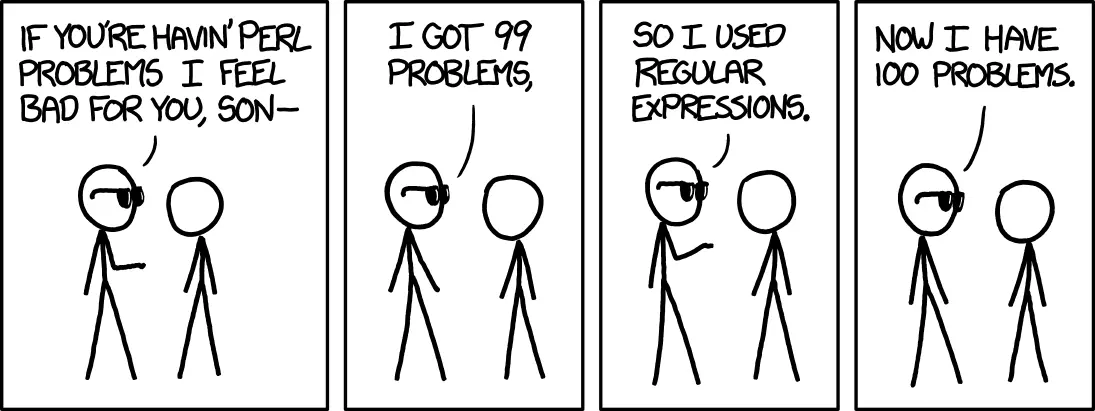Relevant xkcd:

Post funny things about programming here! (Or just rant about your favourite programming language.)
The answer given in the spoiler tag is not quite correct!
Test case
According to the spoiler, this shouldn't match "abab", but it does.
Corrected regex
This will match what the spoiler says: ^.?$|^((.)\2+?)\1+$
Full workup
Any Perl-compatible regex can be parsed into a syntax tree using the Common Lisp package CL-PPCRE. So if you already know Common Lisp, you don't need to learn regex syntax too!
So let's put the original regex into CL-PPCRE's parser. (Note, we have to add a backslash to escape the backslash in the string.) The parser will turn the regex notation into a nice pretty S-expression.
> (cl-ppcre:parse-string "^.?$|^(..+?)\\1+$")
(:ALTERNATION
(:SEQUENCE :START-ANCHOR (:GREEDY-REPETITION 0 1 :EVERYTHING) :END-ANCHOR)
(:SEQUENCE :START-ANCHOR
(:REGISTER
(:SEQUENCE :EVERYTHING (:NON-GREEDY-REPETITION 1 NIL :EVERYTHING)))
(:GREEDY-REPETITION 1 NIL (:BACK-REFERENCE 1)) :END-ANCHOR))
At which point we can tell it's tricky because there's a capturing register using a non-greedy repetition. (That's the \1 and the +? in the original.)
The top level is an alternation (the | in the original) and the first branch is pretty simple: it's just zero or one of any character.
The second branch is the fun one. It's looking for two or more repetitions of the captured group, which is itself two or more characters. So, for instance, "aaaa", or "abcabc", or "abbaabba", but not "aaaaa" or "abba".
So strings that this matches will be of non-prime length: zero, one, or a multiple of two numbers 2 or greater.
But it is not true that it matches only "any character repeated a non-prime number of times" because it also matches composite-length sequences formed by repeating a string of different characters, like "abcabc".
If we actually want what the spoiler says — only non-prime repetitions of a single character — then we need to use a second capturing register inside the first. This gives us:
^.?$|^((.)\2+?)\1+$.
Specifically, this replaces (..+?) with ((.)\2+?). The \2 matches the character captured by (.), so the whole regex now needs to see the same character throughout.
Thanks, I now have insight into my own personal hell for when I die.
Regex is good for a few very specific things, and sysadmins used to use it for goddamn everything. If all your server logs are in lightly-structured text files on a small number of servers, being able to improvise regex is damn useful for tracking down server problems. Just write a shell loop that spawns an ssh logging into each server and running grep over the log files, to look for that weird error.
These days, if you need to crunch production server logs you probably need to improvise in SQL and jq and protobufs or systemd assmonkery or something.
But if you actually need a parser, for goodness sake use a parser combinator toolkit, don't roll your own, especially not with regex. Describing your input language in plain Haskell is much nicer than kludging it.
(This is the "totally serious software engineering advice" forum, right?)
I upvoted this because I hate it.
I upvoted you because I consider Perl write only (used to know it, now it inspires readable code as a high priority)
Let's put it this way: You can produce unreadable code in basically any language. With Perl, it is just a bit easier.
And of course if you have the discipline of a good programmer, even your casual Perl programs should be readable. That's what differenciates a good programmer from a hacker.
Whatever you do, don't get in a time machine back to 1998 and become a Unix sysadmin.
(Though we didn't have CL-PPCRE then. It's really the best thing that ever happened to regex.)
I have to admit that using CL-PPCRE does not really help me understanding the regexp any better. But this may be because I deal with complex regexps for decades now, and I just read them.
It matches “yo momma”.
Just waiting for the oppertunity to hide this in prod.
Syntactically valid Perl
Something like
!"A line with exactly 0 or 1 characters, or a line with a sequence of 1 or 3 or more characters, repeated at least twice"!<
You're misreading the ..+? part. That means 2 or more characters, non greedy.
It's a line with a sequence of two or more characters repeated at least twice.
Only the part after the pipe character. The pipe character works as an "or" operator. RegalPotoo is right.
They said—
A line with exactly 0 or 1 characters, or a line with a sequence of 1 or 3 or more characters, repeated at least twice
Note—
...or a line with a sequence of 1 or 3 or more characters, repeated at least twice
It should be—
...or a line with a sequence of 2 or more characters, repeated at least twice
The regex in the post will match "abab". Their original description (line 2 of this comment) will not match "abab".
I agree, you're right about the part after the pipe and RegalPotoo's explanation was not entirely correct.
Looks like APL to me.